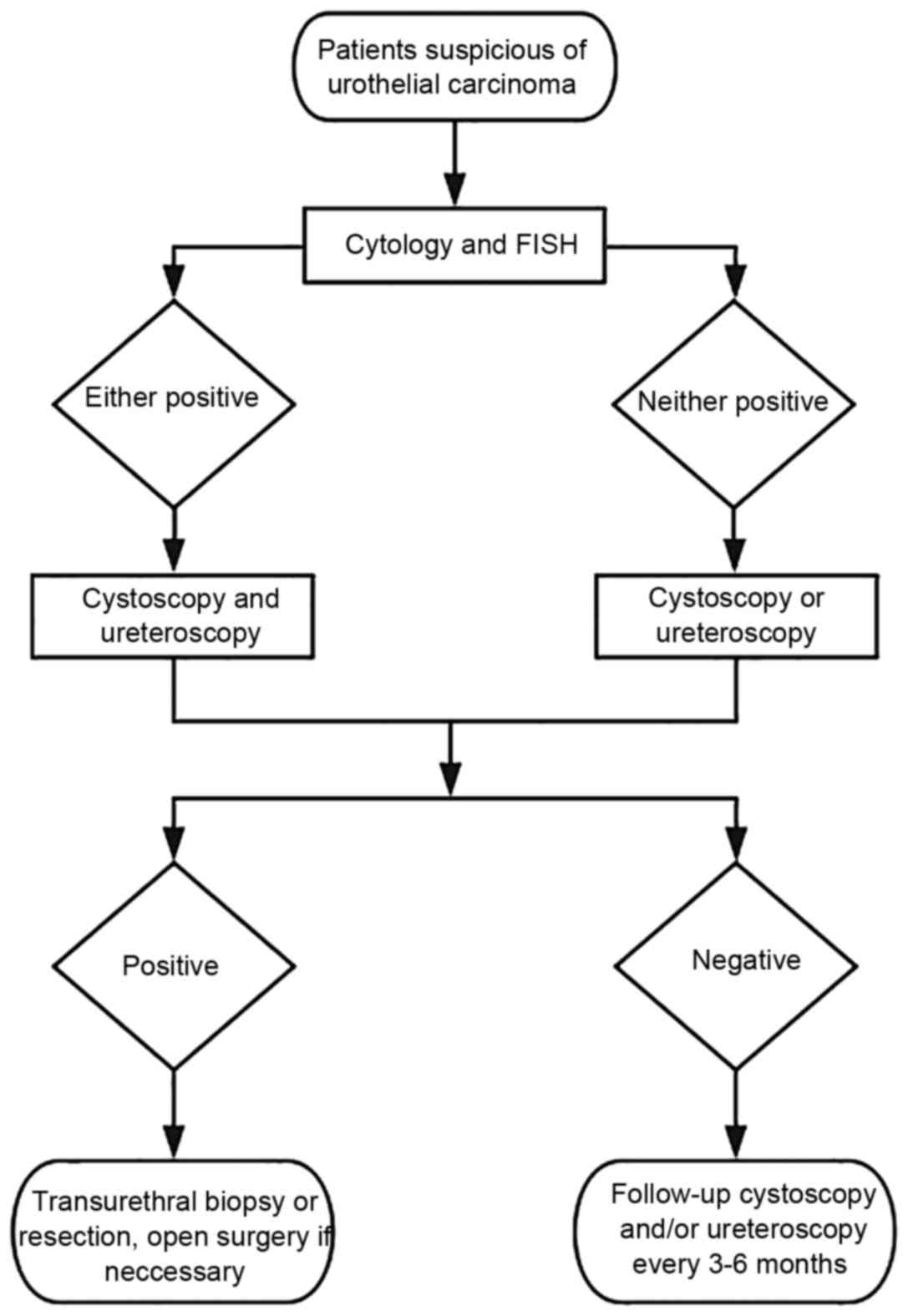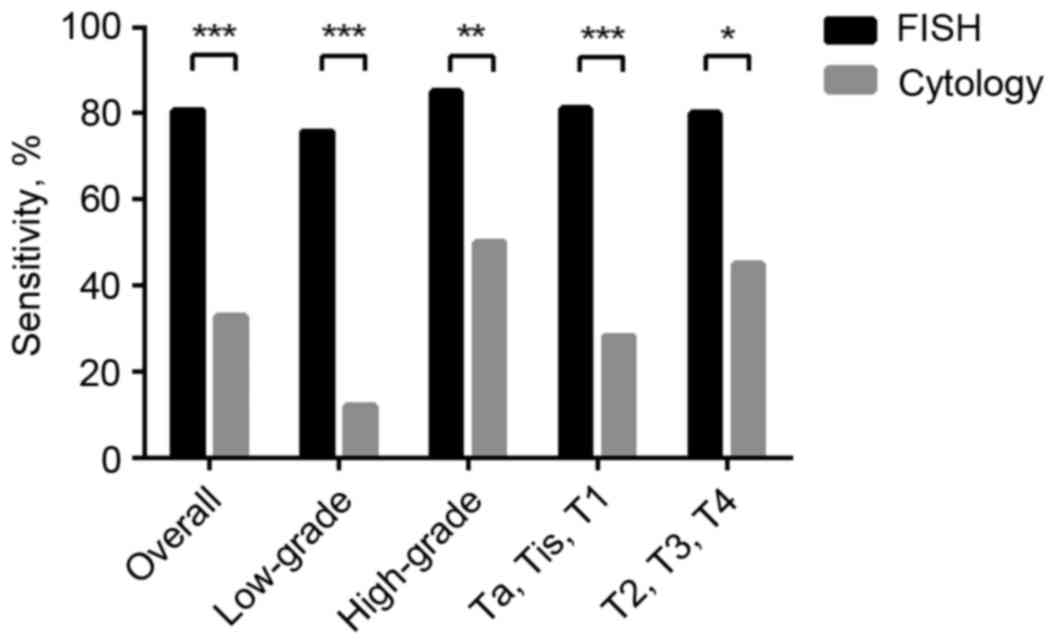|
1
|
Babjuk M, Oosterlinck W, Sylvester R,
Kaasinen E, Böhle A, Palou-Redorta J and Rouprêt M: European
Association of Urology (EAU): EAU guidelines on non-muscle-invasive
urothelial carcinoma of the bladder, the 2011 update. Eur Urol.
59:997–1008. 2011. View Article : Google Scholar : PubMed/NCBI
|
|
2
|
Ries LAG, Young JL, Keel GE, Eisner MP,
Lin YD and Horner MJ: SEER survival monograph: Cancer survival
among adults: U.S. seer program, 1988–2001, patient and tumor
characteristicsNational Cancer Institute, SEER Program. NIH Pub.
No. 07-6215. Bethesda, MD: 2007
|
|
3
|
Siegel RL, Miller KD and Jemal A: Cancer
statistics, 2016. CA Cancer J Clin. 66:7–30. 2016. View Article : Google Scholar : PubMed/NCBI
|
|
4
|
Chen W, Zheng R, Baade PD, Zhang S, Zeng
H, Bray F, Jemal A, Yu QX and Jie H: Cancer statistics in China,
2015. CA Cancer J Clin. 66:115–132. 2016. View Article : Google Scholar : PubMed/NCBI
|
|
5
|
Munoz JJ and Ellison LM: Upper tract
urothelial neoplasms: Incidence and survival during the last 2
decades. J Urol. 164:1523–1525. 2000. View Article : Google Scholar : PubMed/NCBI
|
|
6
|
Sobin LH, Gospodariwicz MK and Wittekind
C: TNM classification of malignant tumours. UICC International
Union Against Cancer (7th). 262–265. 2009.
|
|
7
|
Lutzeyer W, Rübben H and Dahm H:
Prognostic parameters in superficial bladder cancer: An analysis of
315 cases. J Urol. 127:250–252. 1982.PubMed/NCBI
|
|
8
|
Heney NM, Ahmed S, Flanagan MJ, Frable W,
Corder MP, Hafermann MD and Hawkins IR: Superficial bladder cancer:
Progression and recurrence. J Urol. 130:1083–1086. 1983.PubMed/NCBI
|
|
9
|
Herr HW: Natural history of superficial
bladder tumors: 10- to 20-year follow-up of treated patients. World
J Urol. 15:84–88. 1997. View Article : Google Scholar : PubMed/NCBI
|
|
10
|
Freedman ND, Silverman DT, Hollenbeck AR,
Schatzkin A and Abnet CC: Association between smoking and risk of
bladder cancer among men and women. JAMA. 306:737–745. 2011.
View Article : Google Scholar : PubMed/NCBI
|
|
11
|
Zeegers MP, Tan FE, Dorant E and van Den
Brandt PA: The impact of characteristics of cigarette smoking on
urinary tract cancer risk: A meta-analysis of epidemiologic
studies. Cancer. 89:630–639. 2000. View Article : Google Scholar : PubMed/NCBI
|
|
12
|
Crivelli JJ, Xylinas E, Kluth LA, Rieken
M, Rink M and Shariat SF: Effect of smoking on outcomes of
urothelial carcinoma: A systematic review of the literature. Eur
Urol. 65:742–754. 2014. View Article : Google Scholar : PubMed/NCBI
|
|
13
|
Sanderson KM and Rouprêt M: Upper urinary
tract tumour after radical cystectomy for transitional cell
carcinoma of the bladder: An update on the risk factors,
surveillance regimens and treatments. BJU Int. 100:11–16. 2007.
View Article : Google Scholar : PubMed/NCBI
|
|
14
|
Hajdinjak T: Urovysion FISH test for
detecting urothelial cancers: Meta-analysis of diagnostic accuracy
and comparison with urinary cytology testing. Urol Oncol.
26:646–651. 2008. View Article : Google Scholar : PubMed/NCBI
|
|
15
|
Lotan Y and Roehrborn CG: Sensitivity and
specificity of commonly available bladder tumor markers versus
cytology: Results of a comprehensive literature review and
meta-analyses. Urology. 61:109–118. 2003. View Article : Google Scholar : PubMed/NCBI
|
|
16
|
Sokolova IA, Halling KC, Jenkins RB,
Burkhardt HM, Meyer RG, Seelig SA and King W: The development of a
multitarget, multicolor fluorescence in situ hybridization assay
for the detection of urothelial carcinoma in urine. J Mol Diagn.
2:116–123. 2000. View Article : Google Scholar : PubMed/NCBI
|
|
17
|
Bubendorf L: Multiprobe fluorescence in
situ hybridization (UroVysion) for the detection of urothelial
carcinoma-FISHing for the right catch. Acta Cytol. 55:113–119.
2011. View Article : Google Scholar : PubMed/NCBI
|
|
18
|
Mowatt G, Zhu S, Kilonzo M, Boachie C,
Fraser C, Griffiths TR, N'Dow J, Nabi G, Cook J and Vale L:
Systematic review of the clinical effectiveness and
cost-effectiveness of photodynamic diagnosis and urine biomarkers
(FISH, ImmunoCyt, NMP22) and cytology for the detection and
follow-up of bladder cancer. Health Technol Assess. 14:1–331,
iii-iv. 2010. View
Article : Google Scholar
|
|
19
|
Kang JU, Koo SH, Jeong TE, Kwon KC, Park
JW and Jeon CH: Multitarget fluorescence in situ hybridization and
melanoma antigen genes analysis in primary bladder carcinoma.
Cancer Genet Cytogenet. 164:32–38. 2006. View Article : Google Scholar : PubMed/NCBI
|
|
20
|
Marín-Aguilera M, Mengual L, Ribal MJ,
Burset M, Arce Y, Ars E, Oliver A, Villavicencio H, Algaba F and
Alcaraz A: Utility of a multiprobe fluorescence in situ
hybridization assay in the detection of superficial urothelial
bladder cancer. Cancer Genet Cytogenet. 173:131–135. 2007.
View Article : Google Scholar : PubMed/NCBI
|
|
21
|
Dimashkieh H, Wolff DJ, Smith TM, Houser
PM, Nietert PJ and Yang J: Evaluation of urovysion and cytology for
bladder cancer detection: A study of 1835 paired urine samples with
clinical and histologic correlation. Cancer Cytopathol.
121:591–597. 2013. View Article : Google Scholar : PubMed/NCBI
|
|
22
|
Huang JW, Mu JG, Li YW, Gan XG, Song LJ,
Gu BJ, Fu Q, Xu YM and An RH: The utility of fluorescence in situ
hybridization for diagnosis and surveillance of bladder urothelial
carcinoma. Urol J. 11:1974–1979. 2014.PubMed/NCBI
|
|
23
|
Li HX, Wang MR, Zhao H, Cao J, Li CL and
Pan QJ: Comparison of fluorescence in situ hybridization, NMP22
bladderchek and urinary liquid-based cytology in the detection of
bladder urothelial carcinoma. Diagn Cytopathol. 41:852–857.
2013.PubMed/NCBI
|
|
24
|
Banek S, Schwentner C, Täger D, Pesch B,
Nasterlack M, Leng G, Gawrych K, Bonberg N, Johnen G, Kluckert M,
et al: Prospective evaluation of fluorescence-in situ-hybridization
to detect bladder cancer: Results from the uroscreen-study. Urol
Oncol. 31:1656–1662. 2013. View Article : Google Scholar : PubMed/NCBI
|
|
25
|
Huang WT, Li LY, Pang J, Ruan XX, Sun QP,
Yang WJ and Gao X: Fluorescence in situ hybridization assay detects
upper urinary tract transitional cell carcinoma in patients with
asymptomatic hematuria and negative urine cytology. Neoplasma.
59:355–360. 2012. View Article : Google Scholar : PubMed/NCBI
|
|
26
|
Montironi R and Lopez-Beltran A: The 2004
WHO classification of bladder tumors: A summary and commentary. Int
J Surg Pathol. 13:143–153. 2005. View Article : Google Scholar : PubMed/NCBI
|
|
27
|
Connor RJ: Sample size for testing
differences in proportions for the paired-sample design.
Biometrics. 43:207–211. 1987. View
Article : Google Scholar : PubMed/NCBI
|
|
28
|
Beam CA: Strategies for improving power in
diagnostic radiology research. AJR Am J Roentgenol. 159:631–637.
1992. View Article : Google Scholar : PubMed/NCBI
|
|
29
|
Zhou AG, Hutchinson LM and Cosar EF: Urine
cytopathology and ancillary methods. Surg Pathol Clin. 7:77–88.
2014. View Article : Google Scholar : PubMed/NCBI
|
|
30
|
Sarosdy MF, Kahn PR, Ziffer MD, Love WR,
Barkin J, Abara EO, Jansz K, Bridge JA, Johansson SL, Persons DL
and Gibson JS: Use of a multitarget fluorescence in situ
hybridization assay to diagnose bladder cancer in patients with
hematuria. J Urol. 176:44–47. 2006. View Article : Google Scholar : PubMed/NCBI
|
|
31
|
Chen N, Gong J, Zeng H, Wei Q, Zhu YC,
Chen M and Zhou Q: Value of fluorescence in situ hybridization of
urine exfoliative cells in diagnosis of urinary bladder neoplasms.
Sichuan Da Xue Xue Bao Yi Xue Ban. 42:109–113. 2011.(In Chinese).
PubMed/NCBI
|
|
32
|
Bubendorf L, Grilli B, Sauter G, Mihatsch
MJ, Gasser TC and Dalquen P: Multiprobe FISH for enhanced detection
of bladder cancer in voided urine specimens and bladder washings.
Am J Clin Pathol. 116:79–86. 2001. View Article : Google Scholar : PubMed/NCBI
|
|
33
|
Reynolds JP, Voss JS, Kipp BR, Karnes RJ,
Nassar A, Clayton AC, Henry MR, Sebo TJ, Zhang J and Halling KC:
Comparison of urine cytology and fluorescence in situ hybridization
in upper urothelial tract samples. Cancer Cytopathol. 122:459–467.
2014. View Article : Google Scholar : PubMed/NCBI
|
|
34
|
Cui X, Jiang Y, Luo Y, Zhao J and Zhao L:
The impact of various standards in the diagnosis of bladder cancer
by fluorescence in situ hybridization. J Clin Urology. 24:889–891,
894. 2009.
|
|
35
|
Marin-Aguilera M, Mengual L, Ribal MJ,
Musquera M, Ars E, Villavicencio H, Algaba F and Alcaraz A: Utility
of fluorescence in situ hybridization as a non-invasive technique
in the diagnosis of upper urinary tract urothelial carcinoma. Eur
Urol. 51:409–415. 2007. View Article : Google Scholar : PubMed/NCBI
|
|
36
|
Chen AA and Grasso M: Is there a role for
FISH in the management and surveillance of patients with upper
tract transitional-cell carcinoma? J Endourol. 22:1371–1374. 2008.
View Article : Google Scholar : PubMed/NCBI
|
|
37
|
Mian C, Mazzoleni G, Vikoler S, Martini T,
Knüchel-Clark R, Zaak D, Lazica A, Roth S, Mian M and Pycha A:
Fluorescence in situ hybridisation in the diagnosis of upper
urinary tract tumours. Eur Urol. 58:288–292. 2010. View Article : Google Scholar : PubMed/NCBI
|
|
38
|
Smith AK, Larson BT, Berger A and Jones
SJ: Is there a role for cytology in the diagnosis of upper tract
urothelial cancer? J Urology. 181:1322009. View Article : Google Scholar
|
|
39
|
Messer J, Shariat SF, Brien JC, Herman MP,
Ng CK, Scherr DS, Scoll B, Uzzo RG, Wille M, Eggener SE, et al:
Urinary cytology has a poor performance for predicting invasive or
high-grade upper-tract urothelial carcinoma. BJU Int. 108:701–705.
2011.PubMed/NCBI
|
|
40
|
Fadl-Elmula I: Chromosomal changes in
uroepithelial carcinomas. Cell Chromosome. 4:12005. View Article : Google Scholar : PubMed/NCBI
|
|
41
|
Skacel M, Fahmy M, Brainard JA, Pettay JD,
Biscotti CV, Liou LS, Procop GW, Jones JS, Ulchaker J, Zippe CD and
Tubbs RR: Multitarget fluorescence in situ hybridization assay
detects transitional cell carcinoma in the majority of patients
with bladder cancer and atypical or negative urine cytology. J
Urol. 169:2101–2105. 2003. View Article : Google Scholar : PubMed/NCBI
|
|
42
|
Daniely M, Rona R, Kaplan T, Olsfanger S,
Elboim L, Freiberger A, Lew S and Leibovitch I: Combined
morphologic and fluorescence in situ hybridization analysis of
voided urine samples for the detection and follow-up of bladder
cancer in patients with benign urine cytology. Cancer. 111:517–524.
2007. View Article : Google Scholar : PubMed/NCBI
|
|
43
|
Gofrit ON, Zorn KC, Silvestre J, Shalhav
AL, Zagaja GP, Msezane LP and Steinberg GD: The predictive value of
multi-targeted fluorescent in-situ hybridization in patients with
history of bladder cancer. Urol Oncol. 26:246–249. 2008. View Article : Google Scholar : PubMed/NCBI
|
|
44
|
Ferra S, Denley R, Herr H, Dalbagni G,
Jhanwar S and Lin O: Reflex urovysion testing in suspicious urine
cytology cases. Cancer. 117:7–14. 2009.PubMed/NCBI
|
|
45
|
Yoder BJ, Skacel M, Hedgepeth R, Babineau
D, Ulchaker JC, Liou LS, Brainard JA, Biscotti CV, Jones JS and
Tubbs RR: Reflex urovysion testing of bladder cancer surveillance
patients with equivocal or negative urine cytology: A prospective
study with focus on the natural history of anticipatory positive
findings. Am J Clin Pathol. 127:295–301. 2007. View Article : Google Scholar : PubMed/NCBI
|











